On this page
Investing time, effort and resources in children’s early years – when their brains are developing rapidly – brings lifelong benefits to them and to the whole community.
The environments and experiences children are exposed to from pregnancy through to school age shape their development.
Why the AEDC is important
The Australian Early Development Census (AEDC) measures how children have developed by the time they start their first year of full-time school. The AEDC collects data every 3 years in schools across Australia and reports children’s results in 5 key areas of early childhood development called domains.
The South Australia’s 2021 data shows that while there was a 0.5 percentage point increase to 53.7% of children developmentally on track across the 5 AEDC domains (physical health and wellbeing, social competence, emotional maturity, language and cognitive skills (school-based), communication skills and general knowledge), many are developmentally at risk and nearly 1 in 4 children are arriving at school developmentally vulnerable on 1 or more AEDC domains.
South Australia’s 2021 AEDC results are available in 4 snapshots and a map, providing data and key findings in more detail.
Developmental vulnerability can affect lifelong education, health and wellbeing outcomes.
The AEDC can be used as a holistic measure of child development in your community and help you understand how to best support children and families.
There are developmentally vulnerable children in all South Australian communities.
The AEDC provides a strong evidence base that community organisations and local government can use in collaborative planning, implementation and evaluation. Some communities have seen improvement in their AEDC results over time as they implement local collective responses to their AEDC data. To see an example of this, watch the Mid Murray Family Connections story video below.
Find out more in the community section of the AEDC website.
Understanding the AEDC
The AEDC provides comprehensive early childhood data at a community, jurisdictional and national level. It measures 5 important areas of early childhood development called domains.
The AEDC is completed by teachers of children in their first year of full-time school. It is important that all government, independent and Catholic schools participate in the census so that every community can receive data about their children.
Data is summarised in community profiles alongside other relevant demographic data to provide an overview of the contexts of children in each community.
This information can help communities understand the environments and experiences that are shaping children’s development in the early years.
Find out more about the AEDC domains.
Read the understanding the results fact sheet.
Watch the video on understanding the data
Video transcript – understanding the data
Accessing AEDC data
The AEDC results are reported at a national, state, community and school level.
AEDC Data is available in the following formats:
- National, state and territory, community
- AEDC data (data explorer, data products and key findings)
- South Australia
Using AEDC data
When community organisations and local governments use the AEDC as a source of evidence this can contribute to improving children’s likelihood of developing on track and help build thriving communities.
Mid Murray family connections tells the story of how a collective effort of a network of over 60 stakeholders is responding to the AEDC results and seeing positive change in the Mid Murray community. There are many community stories like this from around Australia that can support others to think about how to reflect on and respond to their AEDC data.
Watch the Mid Murray family connections story
Video transcript – Mid Murray family connections story
Amie Johnson: We cover 17 towns, the entire Mid Murray region. The AEDC data showed quiet a shocking picture I think for a lot of people. One in three children were classified as developmentally vulnerable on two or more domains.
Kylie Eggers: 10 or so years ago they did a mapping exercise of our data and realised that there are a lot of gaps and services in our town. We're just outside Murray Bridge, we're just outside the Barossa, we're just outside the Riverland, and so there was a very distinct gap.
John Robertson: This was a real catalyst and wake up call.
Amie Johnson: The initial idea was that Council would invest some staff time to start pulling things together, connecting the threads, you know, building those networks, strategic leaders. It was a really good starting point for council to have a look at what can we do? Who can we pull together? And start building a bit more holistic approach to children and families in our region. We have a network of about 60 partners. We had to choose a starting point. Where would the biggest impact be? So, emotional maturity was chosen by the network because we thought it would filter into those other domains, and because we know that well-being wraps around everything. I remember John Robertson, the Principal of Swan Reach, saying to me, “If they arrive at school when they haven't had breakfast, they haven't slept, unless we address those things, how do we teach them English and Maths?”
Kristy Castle: When I was first introduced to Mid Murray Family Connections. It was a call for mothers, parents or carers to start a Facebook group “Mid Murray Mums”, which it became known as. There were so many kids that weren't quite where they should be to be ready for school. It was crucial to sort of get in there early.
Amie Johnson: There was a big push around the importance of preschool. Parent Child Mother Goose was introduced, which is as you know a preschool learning program.
John Robertson: Swan Reach Area School is a Preschool to Year 12. Sixty three students. Reasonably isolated. It was necessary to put well-being front and centre. Part of the agreement there was that the schools would take on the primary "Kids Matter” preschool, and “Mind Matters” secondary.
Kylie Eggers: The Mannum Way for us, it's a Reception to 12 process of how we can engage. Do as you would to others. Do your best, no matter who you're working with. It takes great strength to be sensible. Those sort of things.
Amie Johnson: So, there's quite a list. Supporting maternal health, connecting child and family health services to towns further out in the region, raising the awareness of the impacts of family violence.
Kylie Eggers: We really want to know where they're at when they first come to us, so that we can build on their strengths, build on what they need working on, and work with their families to ensure that they've got everything they need. The AEDC data is instrumental in making sure that we know where our students are at. For students who are not achieving, say, in their phonics assessment, have they had their hearing checked? We have a lot more conversations with the kindy about who's coming and what they can do, what they need support with, what the family is like and what supports they need.
John Robertson: So Mid Murray Family Connections have been a massive advocate to get these services out. You have CAMHS coming here on occasions. CAFHS now come here. So these services weren't, one seen as needed, perhaps two, known about.
Kristy Castle: The core of the time that I've been involved between the 2015 and the 2018 data, it continued to improve, and I was so impressed because I felt, I felt like what we were doing was actually making a difference.
Amie Johnson: We've worked out four focus areas. Children and caregivers share secure attachment. Children are emotionally resilient. Children are engaged learners, and children and caregivers are safe and supported. We use a community accountability plan that's put together with the whole network, which has got actions moving forward. We then review that plan and look at the new lot of data, look at the community stories.
Kylie Eggers: We know that there's been success because the data is improving over time, and so therefore the students are coming to school more school ready. Parents are coming to us to ask more about what psychological services, what parenting services, what financial support services?
Kristy Castle: If you get the right infographics and the right data to the right people, it just sets off a bit of a chain reaction.
Amie Johnson: What we found is it's been great having an invested position to help keep moving things forward. What it does do is it helps us advocate. It shows the need. This is what my community are telling me and this is what the data is showing. Moving forward we'll assess again. I'm looking forward to the next lot of data.
[End of transcript]
If you have an AEDC story to share, please email Education.AEDCTeam@sa.gov.au.
Use the AEDC as an evidence base to:
- inform policy and planning such as strategic plans, regional public health plans
- review services
- allocate resources and assets
- inform grant processes
- inform collaborative approaches and community engagement
- inform evaluations
- measure progress over time.
The reporting, publication or analysis of AEDC data and results must be in accordance with the AEDC data guidelines.
Find out more about using the data
Video transcript – using the data
Read the user guide: community service organisations, user guide: local government and user guide: policy makers and government executive.
The Local Government Association SA website has information about planning for public health and community wellbeing.
The Regional Public Health Planning: Using the AEDC data guide (PDF 1.1MB) can help local governments use AEDC data to plan for public health in their communities.
Resources
These resources can be used in your work with families to support children’s development in the 5 AEDC domains.
Supporting early childhood development guides
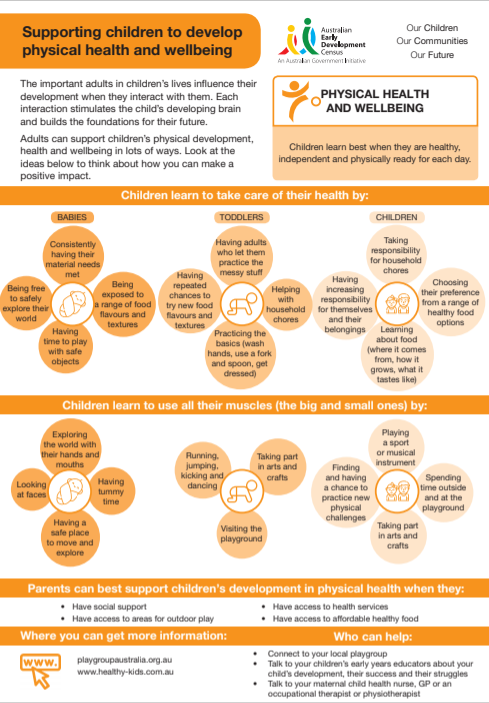
Supporting early childhood development guide: physical health and wellbeing
This fact sheet provides examples of behaviours through which adults can support children’s development of physical health and wellbeing.
Supporting early childhood development guide: physical health and wellbeing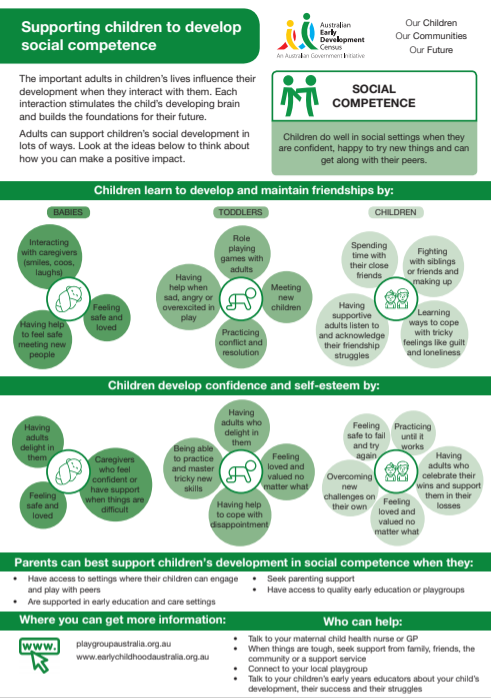
Supporting early childhood development guide: social competence
This fact sheet provides examples of behaviours through which adults can support children’s development of social competence.
Supporting early childhood development guide: social competence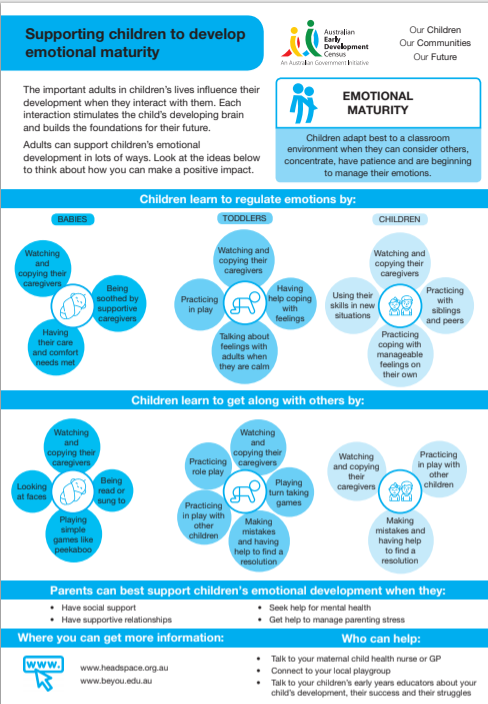
Supporting early childhood development guide: emotional maturity
This fact sheet provides examples of behaviours through which adults can support children’s development of emotional maturity.
Supporting early childhood development guide: emotional maturity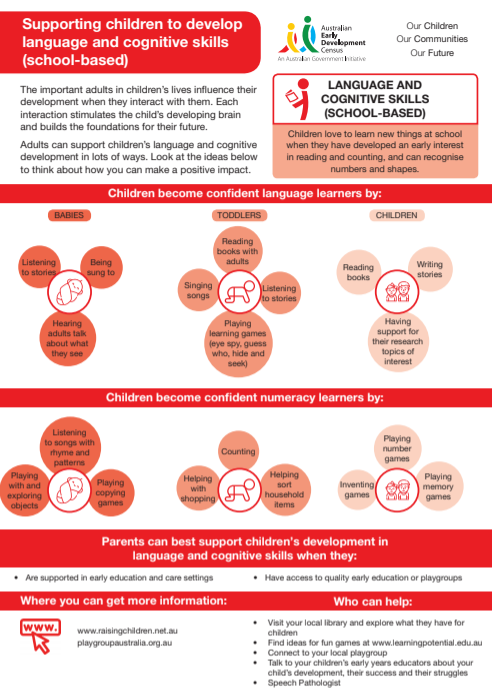
Supporting early childhood development guide: language and cognitive skills (school-based)
This fact sheet provides examples of behaviours through which adults can support children’s development of language and cognitive skills (school-based).
Supporting early childhood development guide: language and cognitive skills (school-based)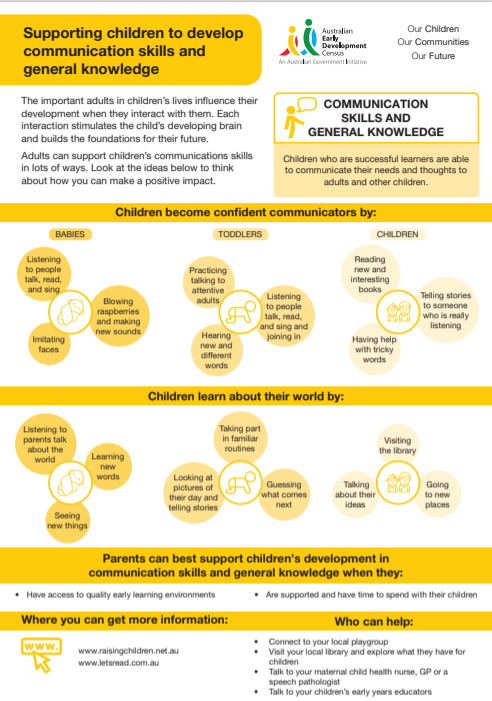
Supporting early childhood development guide: communication skills and general knowledge
This fact sheet provides examples of behaviours through which adults can support children’s development of communication skills and general knowledge.
Supporting early childhood development guide: communication skills and general knowledgeFind out how parents and carers can help support their child's development.
How the AEDC team can help
The AEDC team can:
- help understand your community results
- help understand demographic factors that may be making a difference
- support using the AEDC data.


